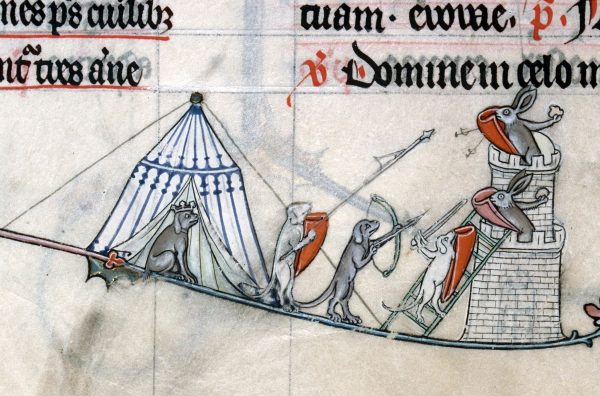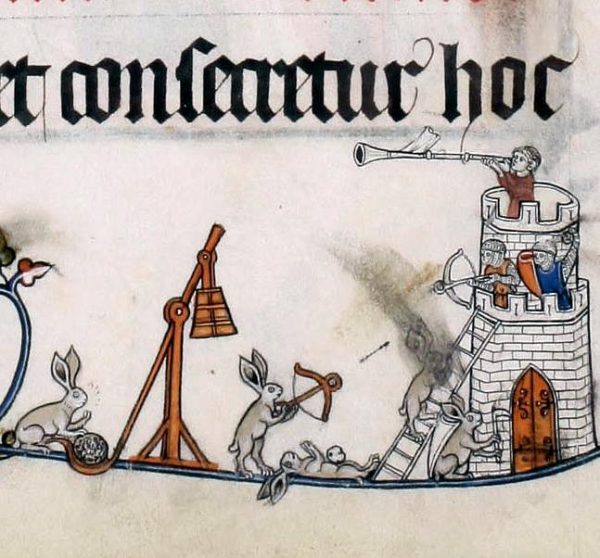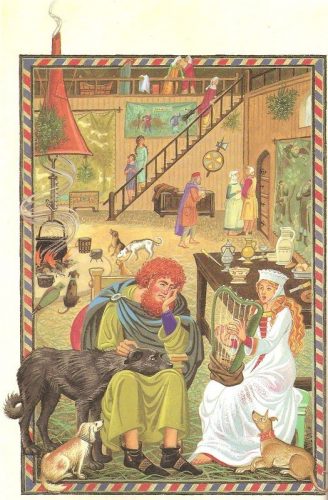
from Diebold Schilling the Elder, Spiezer Chronik, Bern 1484-85 (Bern, Burgerbibliothek, Mss.h.h.I.16, p. 227)
via Discarding Images
I’ve been having fun recently poking around on a Facebook page, Discarding Image, that shares pictures from medieval manuscripts. I’ve been especially fond of the various illustrations that picture more or less anthropomorphic animals acting like people. Rabbits besieging a castle, a boar monk on camel back, and an army of bears with swords and pikes and musical instruments holding a banner with a bear on it.
It struck my sister and I how very Narnian they all were. And she wondered if Lewis had had a chance to see any of these sorts of manuscripts. Well, as a matter of fact, Lewis was a medievalist at Oxford University (and later Cambridge too, where in 1954, he was awarded the newly founded chair of Mediaeval and Renaissance Literature) and there he had access to one of the great collections of medieval manuscripts. As this article about a show at the Bodleian Libraries points out, “The medieval Duke Humfrey’s Library is the reading room in which both Lewis and Tolkien as Oxford dons researched manuscripts and rare books.” Lewis would most certainly have encountered examples of these delightful animals in the course of his perusals. Who knows but that Reepicheep began life inspired by a monk’s marginalia. Certainly this army of bears reminds me very strongly of the three Bulgy Bears in Prince Caspian.
And it also strikes me that medieval manuscript collections would have a familiar mix of the Christian and classical, talking beasts and mythological creatures. Dwarves and centaurs and spirits of trees and Roman gods. There is not a single inhabitant of Narnia that I would be surprised to find within the pages of a medieval manuscript. It made me wonder whether any literary scholar had commented on the possibility of these images as a source of inspiration. Surely I can’t be the first to see a collection of fighting beasts and to think: Narnia lives!

Summer volume of the Breviary of Renaud/Marguerite de Bar, Metz ca. 1302-1305 (Verdun, Bibliothèque municipale, ms. 107, fol. 137r)
via Discarding Images

via Discarding Images
Thinking of Lewis and medieval manuscripts also puts me in mind of the great illustrator, Pauline Baynes, who brought Narnia to life with her beautiful drawings which have such a medieval flair.
Tolkien had written Farmer Giles of Ham, a humorous novella about dragons and knight-errantry set in a faux-medieval period, but was dissatisfied with the work of the artist who had been chosen as illustrator. Baynes’s work caught Tolkien’s eye and she got the job, creating a lively set of pictures that wittily pastiche the look of illuminated medieval manuscripts. So perfectly did Baynes capture the essence of Tolkien’s tale that he declared them to be “more than illustrations, they are a collateral theme”. He also delighted in reporting that friends had said that her pictures had succeeded in reducing his text to “a commentary on the drawings”.
Baynes would later illustrate many authentic medieval stories, all of which show her painstaking research into the detailing of period costume and architecture, and her passion for recreating the texture and fabric of daily life in different ages.
. . . Tolkien’s Farmer Giles was the beginning of a long friendship and repeated collaboration between author and artist with Baynes decorating Tolkien’s subsequent books The Adventures of Tom Bombadil and Smith of Wootton Major and, posthumously, Leaf by Niggle and Bilbo’s Last Song.
Tolkien had expressed the hope that Baynes would illustrate The Lord of the Rings, but the book grew into a gargantuan project that rendered that plan impractical.
I adore Pauline Baynes’ work. I have collected quite a few books with her illustrations over the years, many of them out of print and hard to find. They include: The Song of the Three Holy Children, the canticle from the Book of Daniel; I Believe, the Nicene Creed; In the Beginning, the story of Creation; and Rumer Godden’s The Dragon of Og. But I first encountered her work in my very beloved Chronicles of Narnia.


